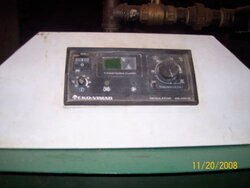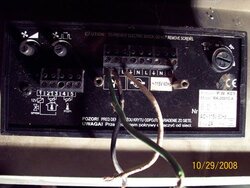Lately there has been a lot of discussion concerning the tweaking of the EKO boiler. I have participated in the discussion myself and though there has been frequent adjustment references to reduce blower settings no one has seemed to have to reduce their blower as far as I have mine. In the last couple of days here in MI we've been getting some of winters best anti-global-warming-trend examples. As the temperature outside has dropped so has the output of my EKO40 (until today).
For the last two days I have been struggling to get my unit up to 140*f. Today's storm just seemed to compound the problem with 30+ mph winds. In the "tweaking your EKO" sticky people have reduced their blowers to 50 & 60% of their former settings in order to get the blue flame of a "tuned" burner. I have the pie plate slider and older controller so I have to adjust the slider to change air flow because I can't slow the motor speed. I have been set at around 3/8 to 1/2" open, at the widest part of the pie, with a reasonably blue/white flame. Going wider causes my boiler temperature to drop even while I'm watching.
Today I set the widest part of the pie slider down to 1/4" and watched the temperature start climbing steadily. I use an air heat exchanger in my old oil furnace and the blower has been running almost constantly the last couple of days and the house has been hovering around 68*f. Now my boiler is back up to temps we're back up to 70*f and comfy.
Has anybody else had to so radically adjust their blower settings? Interested in your input...Thanks
For the last two days I have been struggling to get my unit up to 140*f. Today's storm just seemed to compound the problem with 30+ mph winds. In the "tweaking your EKO" sticky people have reduced their blowers to 50 & 60% of their former settings in order to get the blue flame of a "tuned" burner. I have the pie plate slider and older controller so I have to adjust the slider to change air flow because I can't slow the motor speed. I have been set at around 3/8 to 1/2" open, at the widest part of the pie, with a reasonably blue/white flame. Going wider causes my boiler temperature to drop even while I'm watching.
Today I set the widest part of the pie slider down to 1/4" and watched the temperature start climbing steadily. I use an air heat exchanger in my old oil furnace and the blower has been running almost constantly the last couple of days and the house has been hovering around 68*f. Now my boiler is back up to temps we're back up to 70*f and comfy.
Has anybody else had to so radically adjust their blower settings? Interested in your input...Thanks



